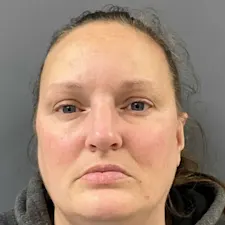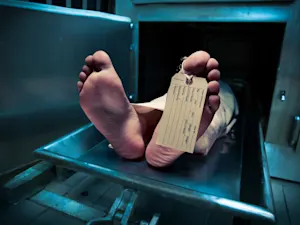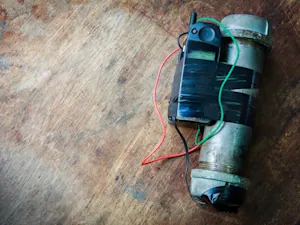
8 Burning Questions From the Real-Life 'Gone Girl' Case
In the early hours of March 23, 2015, a nightmare invaded Aaron Quinn's Vallejo, California, home. A masked intruder woke Aaron and his girlfriend, Denise Huskins, with terrifying precision. What followed seemed ripped from the pages of a psychological thriller — except this was no work of fiction. The couple's lives turned upside down as they endured a crime so bizarre that authorities accused them of fabricating it. Known as the "Gone Girl" kidnapping after a movie of the same name with eerie similarities, this case revealed just how easily reality can outdo fiction. Here's how the story unfolded, and eight key questions it continues to raise.
1. How did everything start?
The night began like any other. Denise and Aaron were asleep when a masked man broke into Aaron's home around 3 a.m. Armed with threats and chilling preparation, the attacker forced Denise to zip-tie Aaron before restraining her. Blacked-out goggles, headphones playing recorded messages and liquid sedatives added layers of terror to the ordeal.
The intruder told Aaron to stay inside a taped-off area of his house, communicate only via text and email, and follow precise instructions to secure Denise's release. Any deviation, he warned, would end in Denise's death. Then, the intruder took Denise and vanished.
2. Why did police suspect a hoax?
Aaron called police hours later, but instead of empathy, he faced suspicion. Investigators grilled him for 18 hours, accusing him of concocting an elaborate lie to cover up a crime. When Denise reappeared two days later in Huntington Beach, California — alive but traumatized — the Vallejo Police Department publicly dismissed the kidnapping as a hoax, claiming the couple wasted public resources.
Detectives even compared the case to the "Gone Girl" movie, in which a woman fakes her disappearance to frame her husband. But Denise and Aaron's nightmare was all too real, and the authorities' refusal to believe them compounded their trauma.
3. What happened to Denise during the abduction?
Denise endured unimaginable horror during her captivity. Her attacker raped her twice, filmed the assaults and threatened to release the footage if she reported him. She told her captor about surviving childhood sexual abuse, hoping it might deter further attacks, but he showed no mercy.
He drugged her before releasing her near her childhood home in Huntington Beach, warning her to lie about the assault and his background. The psychological torment left Denise fearing for her safety and Aaron's.
4. How did the kidnapper get caught?
The case broke open in June 2015, when a botched home invasion in Dublin, California, provided a crucial lead. The suspect fled but left behind a cellphone. That phone led authorities to Matthew Muller, a former Marine and Harvard-trained lawyer.
Inside Muller's home, investigators found zip ties, blackout goggles, and Aaron's stolen laptop — evidence that tied Muller directly to Denise's kidnapping. In 2016, Muller pleaded guilty to federal kidnapping charges and later to state charges, including rape. He's now serving a 40-year sentence.
5. Did Matthew Muller act alone?
Aaron and Denise don't believe Muller acted alone. According to police reports, two cars left Aaron's house after the abduction — one belonging to Aaron and one used to transport Denise. They also found evidence of a second person outside the home early that morning. Despite this, authorities insisted Muller worked solo.
Denise and Aaron remain frustrated by these unanswered questions, believing the lack of a thorough investigation allowed other dangerous criminals to escape justice.
6. Was Denise really the intended target?
A chilling twist emerged during the investigation: Muller may not have planned to abduct Denise at all. Emails sent to reporters suggested that Aaron's ex-girlfriend, Andrea Roberts, was the intended target. Muller later told Aaron he'd mistakenly kidnapped Denise.
Complicating matters further, Aaron discovered Roberts had a prior relationship with FBI Agent David Sesma, who worked on Denise's case. Aaron flagged this conflict of interest, but federal authorities dismissed his concerns.
7. What went wrong with the investigation?
The Vallejo Police Department's mishandling of the case remains one of its most controversial aspects. Detectives fixated on the hoax theory, ignoring key evidence, and failing to follow up on leads.
Denise and Aaron's treatment by police sparked widespread outrage. The couple sued the city of Vallejo for defamation and false imprisonment, ultimately winning a $2.5 million settlement and a formal apology.
8. How did Denise and Aaron rebuild their lives?
Despite everything, Denise and Aaron rebuilt their lives piece by piece. They married in 2018 and welcomed two daughters, Olivia and Naomi, who they call their "happy ending," as reported by TODAY. They also co-authored "Victim F: From Crime Victims to Suspects to Survivors," sharing their story to advocate for other survivors.
A Netflix® docuseries "American Nightmare" has brought renewed attention to their ordeal, shedding light on the flaws in the justice system and the dangers of victim-blaming.
From Victims to Advocates
Denise and Aaron's story is a testament to resilience. They survived not only a harrowing crime but also the crushing weight of public doubt and institutional failure. By speaking out, they've turned their pain into a mission to support other victims and push for systemic change.
Their nightmare began with a crime, but it's their courage and determination that define the final chapter.
References: American Nightmare: Where Are Denise Huskins and Aaron Quinn Now After the 'Gone Girl Kidnapping'? | 'American Nightmare' couple still have questions about the kidnapping. Here are a few























